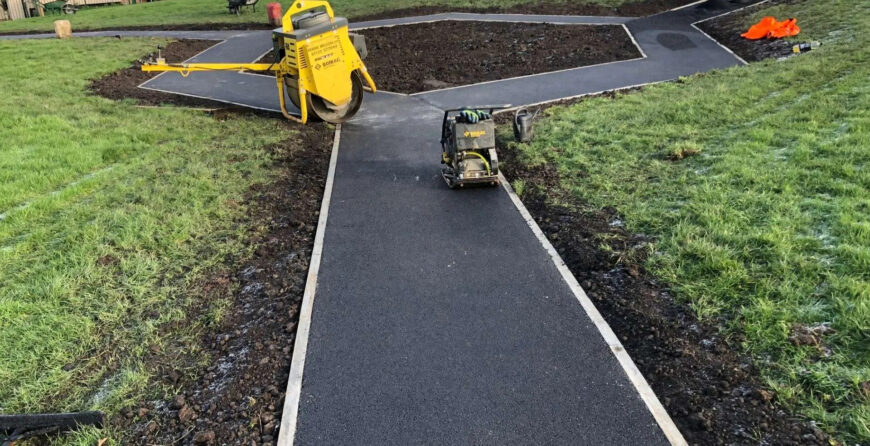Introduction
Road surfacing is a critical aspect of infrastructure development, ensuring that roads are safe, durable, and efficient for transportation. The process of road surfacing involves multiple steps, from the selection of materials to the application of various layers, all designed to withstand the pressures of traffic and environmental conditions. This blog will explore the importance of road surfacing, the different types of materials used, the process involved, and why quality road surfacing is essential for both public and private sectors.
1. The Importance of Road Surfacing
Roads are the arteries of modern society, facilitating the movement of people, goods, and services. The quality of road surfaces directly impacts the safety, efficiency, and longevity of these vital pathways. Poorly surfaced roads can lead to accidents, increased vehicle maintenance costs, and overall inefficiency in transportation networks.
a. Safety
The primary concern in road surfacing is safety. A well-surfaced road provides a smooth and consistent driving experience, reducing the risk of accidents. Proper drainage systems, skid resistance, and even surfaces are crucial elements that contribute to road safety. Uneven or poorly maintained roads can cause vehicles to lose control, especially in adverse weather conditions.
b. Durability and Longevity
Quality road surfacing ensures that roads can withstand the pressures of heavy traffic and harsh environmental conditions. Roads that are properly surfaced with high-quality materials are less prone to cracking, potholes, and other forms of degradation. This durability reduces the need for frequent repairs, saving both time and money in the long run.
c. Economic Impact
The economic impact of road surfacing cannot be overstated. Well-maintained roads contribute to the efficiency of transportation networks, reducing travel time and fuel consumption. This efficiency translates into economic benefits for businesses and the economy as a whole. Conversely, poorly surfaced roads can lead to increased vehicle maintenance costs, delays, and higher transportation costs.
d. Environmental Considerations
Modern road surfacing techniques also consider environmental impacts. Sustainable materials and processes are increasingly being used to minimize the carbon footprint associated with road construction and maintenance. This approach not only benefits the environment but also aligns with the growing demand for sustainable infrastructure.
2. Types of Road Surfacing Materials
Different materials are used in road surfacing, each with its own set of advantages and applications. The choice of material depends on factors such as traffic volume, climate, and budget. Here, we explore some of the most commonly used road surfacing materials.
a. Asphalt
Asphalt is one of the most popular road surfacing materials, known for its flexibility, durability, and cost-effectiveness. It is made from a mixture of aggregates, binder (bitumen), and filler. Asphalt is ideal for roads that experience high traffic volumes due to its ability to withstand heavy loads and resist wear and tear.
Advantages of Asphalt:
- Flexibility: Asphalt can expand and contract with temperature changes, reducing the risk of cracks.
- Quick Installation: Asphalt roads can be laid and used relatively quickly, minimizing disruptions.
- Cost-Effective: Asphalt is generally less expensive than other materials, making it a popular choice for many road projects.
b. Concrete
Concrete is another widely used material in road surfacing, particularly for highways and roads that require long-lasting durability. Unlike asphalt, concrete is rigid and offers excellent resistance to deformation and wear.
Advantages of Concrete:
- Durability: Concrete roads have a longer lifespan compared to asphalt roads.
- Low Maintenance: Concrete requires less frequent maintenance, reducing long-term costs.
- High Load-Bearing Capacity: Concrete can support heavy loads, making it ideal for highways and industrial areas.
c. Gravel
Gravel is often used for rural roads and less trafficked areas. It is an affordable option that provides a solid surface for vehicles, though it requires regular maintenance to keep the surface even and free from potholes.
Advantages of Gravel:
- Affordability: Gravel is one of the most cost-effective road surfacing options.
- Ease of Installation: Gravel roads can be quickly installed and repaired.
- Good Drainage: Gravel allows for natural drainage, reducing the risk of water damage.
d. Composite Materials
Composite materials, such as asphalt-concrete composites, combine the benefits of both asphalt and concrete. These materials are used in areas where both flexibility and durability are required.
Advantages of Composite Materials:
- Versatility: Composite materials can be tailored to specific needs and conditions.
- Enhanced Performance: By combining different materials, composite surfaces offer improved durability and longevity.
- Sustainability: Many composite materials are designed to be environmentally friendly, using recycled materials and reducing waste.
3. The Road Surfacing Process
The process of road surfacing involves several key stages, each critical to the success and longevity of the final product. From initial planning to the final application, each step must be carefully executed to ensure a high-quality surface.
a. Planning and Design
The road surfacing process begins with careful planning and design. This stage involves assessing the specific needs of the project, such as traffic volume, climate conditions, and the desired lifespan of the road. Engineers and planners work together to design a road that meets these requirements while staying within budget.
b. Subgrade Preparation
Before any surfacing material is applied, the subgrade must be prepared. This involves grading and compacting the soil to create a stable foundation for the road. Proper subgrade preparation is essential for preventing future issues such as settling, cracking, and water damage.
c. Base Layer Application
The base layer is the first layer of material applied to the prepared subgrade. This layer provides additional support and helps distribute the weight of traffic evenly across the road. Common materials used for the base layer include crushed stone, gravel, and recycled asphalt.
d. Surfacing Layer Application
Once the base layer is in place, the surfacing material is applied. This is the visible layer of the road and can be made from asphalt, concrete, or other materials. The surfacing layer is applied using specialized equipment to ensure a smooth and even finish.
e. Compaction and Finishing
After the surfacing material is applied, it must be compacted to achieve the desired density and strength. This is done using rollers and other compaction equipment. The final finishing touches, such as line markings and signage, are then added to complete the road.
f. Quality Control and Testing
Quality control is a critical part of the road surfacing process. Throughout the project, various tests are conducted to ensure that the materials and workmanship meet the required standards. These tests may include density testing, skid resistance testing, and surface smoothness assessments.
4. Challenges in Road Surfacing
While road surfacing is essential for maintaining safe and functional roads, it is not without its challenges. Various factors can complicate the process and impact the quality of the final product.
a. Weather Conditions
Weather conditions play a significant role in road surfacing. Extreme temperatures, rain, and humidity can all affect the quality of the materials and the ability to apply them correctly. For example, asphalt may not bond properly if applied in cold weather, leading to premature cracking.
b. Traffic Management
Road surfacing often requires partial or full road closures, which can cause disruptions to traffic. Managing traffic during road surfacing projects is a complex task that requires careful planning and coordination with local authorities to minimize inconvenience to the public.
c. Material Selection
Choosing the right materials for road surfacing is critical to the success of the project. Factors such as traffic volume, climate, and budget must all be considered when selecting materials. Poor material choices can lead to premature wear and tear, increasing the need for repairs.
d. Environmental Considerations
The environmental impact of road surfacing is another challenge that must be addressed. The production and application of materials such as asphalt and concrete can have significant environmental consequences, including greenhouse gas emissions and resource depletion. Sustainable practices, such as using recycled materials and reducing waste, are increasingly being adopted to mitigate these impacts.
5- The Role of Technology in Road Surfacing
In recent years, technological advancements have revolutionized the road surfacing industry, making the process more efficient, durable, and sustainable. At PaveRose, we recognize the importance of integrating cutting-edge technology into our road surfacing practices to deliver superior results.
One of the key technological innovations in road surfacing is the use of advanced materials. For example, polymer-modified bitumen (PMB) has become increasingly popular due to its enhanced flexibility and resistance to deformation. PMB improves the longevity of road surfaces, reducing the need for frequent maintenance and repairs. Additionally, the incorporation of recycled materials, such as reclaimed asphalt pavement (RAP), has become a standard practice in the industry. This not only reduces the environmental impact of road construction but also lowers costs without compromising quality.
Another significant advancement is the use of automated and precision machinery in the road surfacing process. Modern pavers and compactors are equipped with GPS technology, allowing for precise control of the thickness and alignment of the road surface. This ensures a smoother, more uniform finish, which enhances the safety and comfort of the road. Moreover, the use of infrared scanners allows for real-time monitoring of the temperature of asphalt mixtures during application. This ensures that the material is laid at the optimal temperature, preventing issues such as premature cracking or uneven surfaces.
Digital technology has also played a crucial role in improving the planning and management of road surfacing projects. Software solutions enable more accurate design and simulation of road surfaces, allowing engineers to predict how different materials and methods will perform under various conditions. This leads to more informed decision-making and better outcomes for road users.
In conclusion, the integration of technology into road surfacing has led to significant improvements in the quality, efficiency, and sustainability of road construction. At PaveRose, we are committed to staying at the forefront of these advancements, ensuring that our clients benefit from the latest innovations in the industry.
Location:
PaveRose proudly offers its comprehensive landscaping, lawn care, and paving services across a wide range of areas in the UK. Our expert team serves the communities of Brentwood, Shenfield, Billericay, Wickford, and Basildon, ensuring beautifully maintained lawns and professionally paved driveways that enhance the curb appeal of your property. In South Benfleet, Hadleigh, Rayleigh, and Hullbridge, we bring our attention to detail and dedication to excellence to every project, whether it’s garden maintenance or patio installation. For those in Hockley, South Woodham Ferrers, Danbury, Maldon, and Chelmsford, PaveRose is your go-to provider for all your landscaping needs. We understand the unique characteristics of each area we serve, allowing us to deliver tailored solutions that meet the specific needs of each location. From the historic streets of Maldon to the vibrant communities of Rayleigh and Chelmsford, our services are designed to blend seamlessly with the local environment while adding value and beauty to your property. Whether you’re in the heart of Brentwood or the scenic surroundings of Danbury, PaveRose is committed to delivering exceptional results with every project.
Ready to improve your lawn? Visit our PaveRose listing on Scoot to see our full range of services and to schedule your first appointment!
#LawnCare #GardeningTips #PaveRose #GardenMaintenance #UKGardening #HealthyLawn #LawnCareGuide #OutdoorLiving #LawnCareTips #GreenThumb #LawnMaintenance #GrassCare #LawnCareUK #GardeningUK #LawnCareServices #GardeningAdvice #BeautifulLawns #LandscapeDesign #GardenCare #EcoFriendlyGardening




